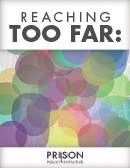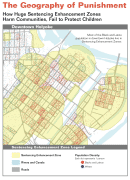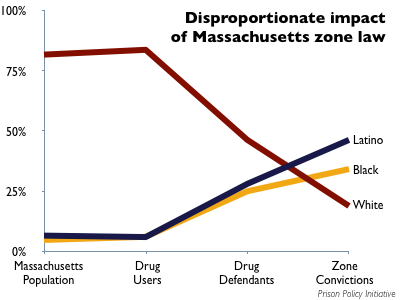New video takes on War on Drug’s worst idea: Sentencing Enhancement Zones
Our new video explains that sentencing enhancement zone laws (a.k.a. school zone laws) do not work and will never work.
by Peter Wagner, June 30, 2014
One of our specialties here at the Prison Policy Initiative is explaining the geographic implications of criminal justice policy. Sometimes we focus on how criminal justice policy — and the forced migration of millions of people to remote prisons cells — distorts our electoral process through prison gerrymandering.
We’ve also been working from the other end, focusing on the geographically-flawed thinking in state legislatures that punishes some drug crimes more severely because they happen to be committed in an urban area. These laws don’t work, can’t ever work, and lead directly to increasing the racial disparities in our nation’s prisons.
Over the years, we’ve done a number of detailed state specific reports about the problem and the obvious solutions, and today we present a short video that explains the fundamental flaw in these laws: When you make everywhere special, nowhere is special.
For more information, see our overview page about sentencing enhancement zones, and some of our previous reports:
 Reaching too far: How Connecticut’s large sentencing enhancement zones miss the mark
Reaching too far: How Connecticut’s large sentencing enhancement zones miss the mark
by Aleks Kajstura, March 2014.
This report analyzes Connecticut’s 1,500-foot sentencing enhancement zones, mapping the zones in the state’s cities and towns and demonstrating both that the law is ineffective, and that it creates an “urban penalty”. The Geography of Punishment: How Huge Sentencing Enhancement Zones Harm Communities, Fail to Protect Children
The Geography of Punishment: How Huge Sentencing Enhancement Zones Harm Communities, Fail to Protect Children
by Aleks Kajstura, Peter Wagner and William Goldberg, July 2008.
This first-of-a-kind report mapped every sentencing enhancement zone in urban, rural and suburban Hampden County, and quantified the race and ethnicity of the people who live inside and outside of the zones. Reaching too far, coming up short: How large sentencing enhancement zones miss the mark
Reaching too far, coming up short: How large sentencing enhancement zones miss the mark
by Aleks Kajstura, Peter Wagner and Leah Sakala
January, 2009.
This followup report again focusing on Hampden County Massachusetts found that Blacks are 26 times as likely, and Latinos 30 times as likely as White residents to be convicted and receive a mandatory sentencing enhancement zone sentence.







[…] Alternative Spring Break participant Arielle Sharma, research associate Elydah Joyce, and programmer Jacob Mitchell put together the illustration below to show just how far 1,500 feet really is. Just click on the image to understand why school zones fail to keep children safe. And check out our zones page for updates on the pending Connecticut bill that would roll back these zones, our reports on zones in Connecticut and Massachusetts, and our zones video. […]